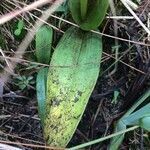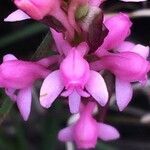Plants (11-)20-70 cm tall. Tubers oblong-ellipsoid to ellipsoid, 2-5 × 0.5-1.5 cm. Stem with 1-3 membranous sheaths at base, 1-3-leaved. Leaves usually basal and subopposite, or sometimes cauline and widely spaced and alternate, broadly ovate, ovate-lanceolate, or lanceolate-oblong, 4-19 × 2-5.5(-8) cm, slightly fleshy, margin somewhat crisped, apex acute or acuminate. Peduncle 6-30 cm, slender to stout, with several large, foliaceous, tubular bracts, glabrous; rachis 4-20 cm, laxly 10-to subdensely more than 20-flowered; floral bracts reflexed, ovate-lanceolate, 8-35 × 4-10 mm. Flowers fragrant, widely spreading, whitish, pink, or pale purple, glabrous, hermaphroditic or with reduced stamen and functionally female; pedicel and ovary 6-10 mm, glabrous. Dorsal sepal narrowly oblong-elliptic, 4-6 × 1-1.8 mm, apex obtuse; lateral sepals oblong to subovate, slightly oblique, 4-6 × 1.5-2 mm, apex obtuse. Petals narrowly oblong to narrowly elliptic, 3.5-5 × 1-1.2 mm, outer surface carinate, margin sometimes finely ciliate, apex acute to obtuse and sometimes incised; lip hooded, subglobose, 5-6 × 4-6 mm, outer surface carinate, 2-spurred, margin sometimes irregularly dentate, apex acute or obtuse and often deflexed; spurs parallel, slender and cylindric, to stout and conic, curving downward, 3-13 mm, or reduced and saclike, or rarely absent altogether. Column incurved, 4-5 mm.
More
An orchid. It grows in the ground. It grows 20-70 cm tall. The tubers are oblong and 2-5 cm long by 1-2 cm wide. The stem has 1-3 thin sheaths at the base. The leaves are oblong and end abruptly. They are 4-19 cm long by 2-6 cm wide. The leaves sheath the base. The flowers are pink. They have a scent.
Forests, open forests, grassy slopes and alpine slopes; at elevations from 1,000-4,200 metres. Cool, open grasslands.
More
A tropical plant. In Nepal it grows between 600-4600 m altitude. It grows in moist places. In Sichuan and Yunnan.


